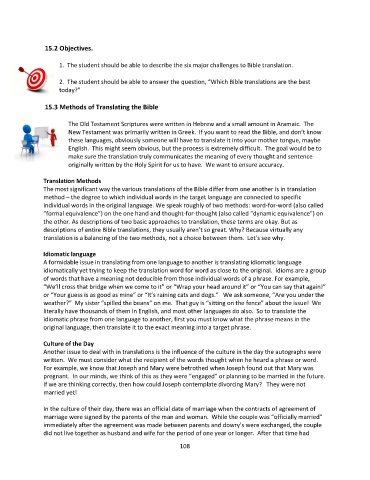Page 109 - Doctrine and History of the Preservation of the Bible Student Textbook
P. 109
15.2 Objectives.
1. The student should be able to describe the six major challenges to Bible translation.
2. The student should be able to answer the question, “Which Bible translations are the best
today?”
15.3 Methods of Translating the Bible
The Old Testament Scriptures were written in Hebrew and a small amount in Aramaic. The
New Testament was primarily written in Greek. If you want to read the Bible, and don’t know
these languages, obviously someone will have to translate it into your mother tongue, maybe
English. This might seem obvious, but the process is extremely difficult. The goal would be to
make sure the translation truly communicates the meaning of every thought and sentence
originally written by the Holy Spirit for us to have. We want to ensure accuracy.
Translation Methods
The most significant way the various translations of the Bible differ from one another is in translation
method – the degree to which individual words in the target language are connected to specific
individual words in the original language. We speak roughly of two methods: word-for-word (also called
“formal equivalence”) on the one hand and thought-for-thought (also called “dynamic equivalence”) on
the other. As descriptions of two basic approaches to translation, these terms are okay. But as
descriptions of entire Bible translations, they usually aren’t so great. Why? Because virtually any
translation is a balancing of the two methods, not a choice between them. Let’s see why.
Idiomatic language
A formidable issue in translating from one language to another is translating idiomatic language
idiomatically yet trying to keep the translation word for word as close to the original. Idioms are a group
of words that have a meaning not deducible from those individual words of a phrase. For example,
“We’ll cross that bridge when we come to it” or “Wrap your head around it” or “You can say that again!”
or “Your guess is as good as mine” or “It’s raining cats and dogs.” We ask someone, “Are you under the
weather?” My sister “spilled the beans” on me. That guy is “sitting on the fence” about the issue! We
literally have thousands of them in English, and most other languages do also. So to translate the
idiomatic phrase from one language to another, first you must know what the phrase means in the
original language, then translate it to the exact meaning into a target phrase.
Culture of the Day
Another issue to deal with in translations is the influence of the culture in the day the autographs were
written. We must consider what the recipient of the words thought when he heard a phrase or word.
For example, we know that Joseph and Mary were betrothed when Joseph found out that Mary was
pregnant. In our minds, we think of this as they were “engaged” or planning to be married in the future.
If we are thinking correctly, then how could Joseph contemplate divorcing Mary? They were not
married yet!
In the culture of their day, there was an official date of marriage when the contracts of agreement of
marriage were signed by the parents of the man and woman. While the couple was “officially married”
immediately after the agreement was made between parents and dowry’s were exchanged, the couple
did not live together as husband and wife for the period of one year or longer. After that time had
108

